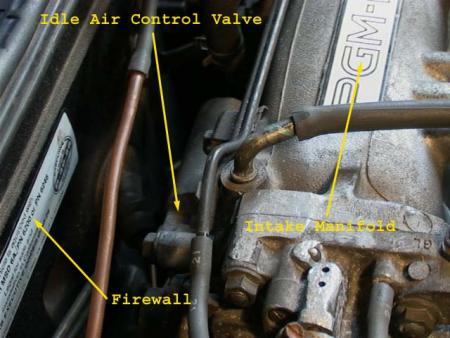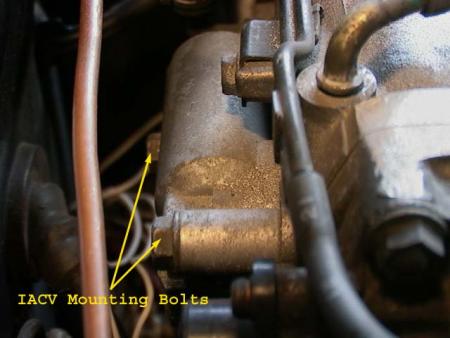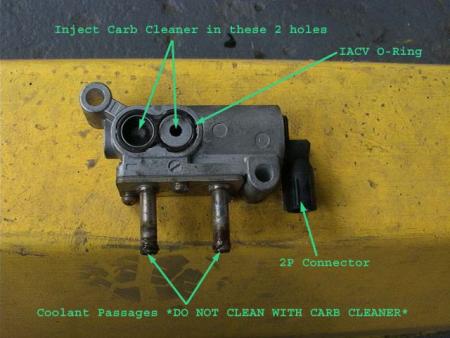[u]NOTES FROM THE AUTHOR[/u]
Well, BR explained it pretty simply. So, when I was able to rent the digicam the other day, I decided to clean the IACV and post it up. This is pretty straightforward, with the coolant lines being the only hassle (probably because I’m just too weak ![]() ).
).
[u]CREDITS[/u]
BR - Well, he opened the doors and pretty much explained things very well. ![]()
[u]INTRODUCTION[/u]
Task: Idle Air Control Valve (IACV) Removal, Installation, Cleaning
Difficulty: Easy
Time Required: Actual work is 30 minutes. Drying time is 3 hours depending on your preference.
Engine Used in this Guide: 89-91 B16A
Engines Applicable: Other B-Series engines will differ, but the idea is basically the same.
[u]TOOLS REQUIRED[/u]
- 3/8" Ratchet
- 3/8" 12mm Socket
- 12mm Closed-End Wrench (if Ratchet is not available)
- Assorted Long Nose Pliers
- Carb Cleaner (readily available at your local Automotive Store)
- Towels
- Air Compressor
- Compressed Gas Can such as “Dust-Off” (used for computers) can be substituted if Air compressor is not available.
NOTE: If the pictures do not show, click here for the album: http://www.imagestation.com/album/?id=4291328805
[u]STEP 1[/u]
Figure 1 shows the location of the IACV. Get yourself familiarized with what you’re about to do. NOTE: It is highly recommended that you do the work with the engine COLD.
Fig. 1 - IACV Location inside Engine Bay

[u]STEP 2[/u]
Take a 12mm socket or wrench and remove the bolts shown in Fig. 2. The IACV will simply detach itself from the intake manifold.
Fig. 2 - Remove Mounting Bolts

[u]STEP 3[/u]
Once the bolts are removed, you need to remove the 2 coolant hoses and the 2P Connector from the IACV. Use long-nose pliers to loosen the clamps that hold the coolant hoses tight. Fig. 3 shows the IACV removed from the engine and I have highlighted the items for clarity. Be careful not lose that O-Ring!!
Fig. 3 - Where everything is

[u]STEP 4[/u]
Refer again to Figure 3 in Step 3 for reference. Take the Carb Cleaner and liberally spray the inside of the 2 holes shown in Figure 3. It may be best to remove the O-Ring if possible as I noticed that the Carb Cleaner SWELLED the rubber. However, the swelling should subside in a couple of hours. Once you are finished with the Carb Cleaner, take the Air Compressor and inject compressed air in the holes to dry.
What I have done is this: Spent approx. 30 seconds per hole injecting it with Carb Cleaner. Then spent 2 min. per hole with the Air Compressor. I then flooded the 2 holes with Carb Cleaner again and laid it down on the ground as shown in Figure 3. I left it soaking like that for approx. 1 hour. After which, I pumped the air compressor again to dry it. Just to be on the safe side, I left it to “natural dry” for 2 hours before installing it back on the engine.
[u]STEP 5[/u]
Installation is reverse. Do not mix the Coolant hoses around. Although, I do not see any forseeable damage if you do (just be on the safe side, though). Don’t forget the O-Ring gasket. That is quite important if you want to minimize air leaks. Take your baby out for a spin!
[u]CONCLUSION[/u]
As far as I know, the IACV does not operate unless the engine has reached normal operating temperatures. Until it does, the Fast Idle Thermo Valve does the work. Again, I could be wrong. In any case, it is better to test the IACV while the engine has completely warmed up.
My bouncing idle has been fixed previously. However, I have noticed I feel less vibration in the cockpit during Idle after this maintenance.
If you have any questions, either post 'em here or email me at the_oz@hotmail.com
Regards,
Oz


